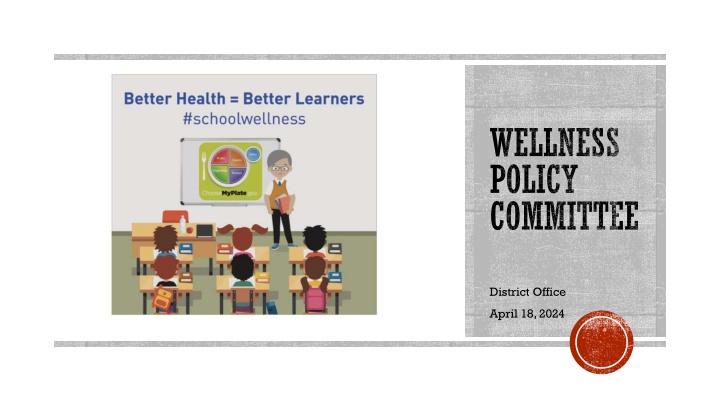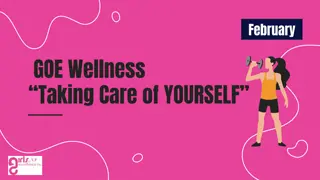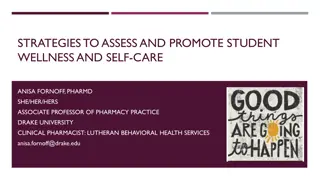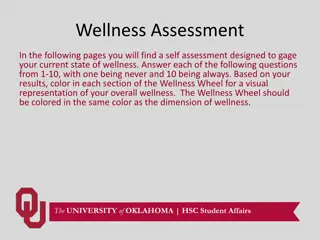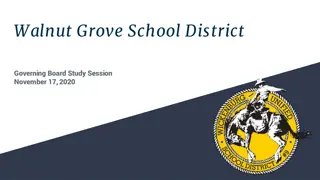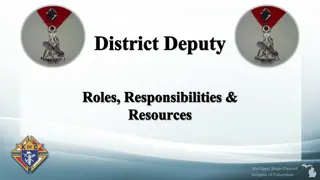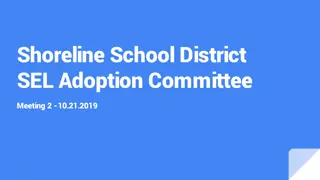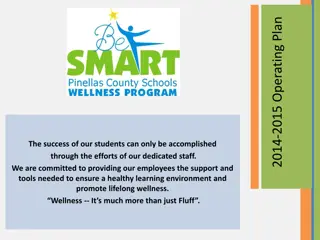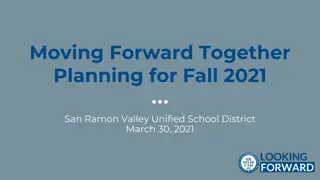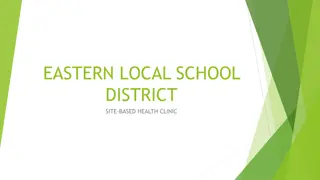Wellness Policy Committee at District Office
The Wellness Policy Committee plays a vital role in ensuring physical well-being, growth, development, and readiness to learn in schools. Comprised of various stakeholders, the committee communicates, advises, develops, implements, and reviews wellness policies, focusing on nutrition education, promotion, physical activity, and other activities that enhance student wellness.
Download Presentation

Please find below an Image/Link to download the presentation.
The content on the website is provided AS IS for your information and personal use only. It may not be sold, licensed, or shared on other websites without obtaining consent from the author.If you encounter any issues during the download, it is possible that the publisher has removed the file from their server.
You are allowed to download the files provided on this website for personal or commercial use, subject to the condition that they are used lawfully. All files are the property of their respective owners.
The content on the website is provided AS IS for your information and personal use only. It may not be sold, licensed, or shared on other websites without obtaining consent from the author.
E N D
Presentation Transcript
WELLNESS POLICY COMMITTEE District Office April 18, 2024
BIG SPRING WELLNESS COMMITTEES BSSD Wellness Most visible Mrs. Header run Wellness Committee CBA reps and Administration Discuss Health Care Concerns and Changes Wellness Policy Committee
WELLNESS POLICY: PURPOSE Physical well-being Growth Development Readiness to learn
WHY DO WE HAVE A WELLNESS POLICY? A wellness policy helps create a healthy school environment. Our wellness policy includes four important components: Wellness Policy Committee Nutrition Education Nutrition Promotion Physical Activity Compliance Policy 246 and Healthy, Hunger Free Kids Act (HHFKA) If policy and rules are not followed, District is at risk of funding being delayed or forfeited
WELLNESS POLICY COMMITTEE School Board Member District Administrator District Food Service Representative Student Parent/Guardian School Health Professional Physical Education Teacher Member of the Public
WELLNESS POLICY COMMITTEE Communicates and advices on student health issues Responsible for development, implementing and periodically reviewing wellness policy Reviews and considers evidence-based strategies and techniques in establishing goals for: Nutrition education and promotion Physical activity Other school-based activities that promote student wellness
NATIONAL SCHOOL LUNCH PROGRAM (NSLP) President Harry S. Truman signed the National School Lunch Act on June 4, 1946. The legislation came in response to claims that many American men had been rejected for World War II military service because of diet-related health problems. The federally assisted meal program was established as a measure of national security, to safeguard the health and well-being of the Nation s children and to encourage the domestic consumption of nutritious agricultural commodities. The National School Lunch Act has since been amended numerous times.
WHAT IS OFFER VS SERVE? Allows students to decline a certain number of food items Minimizes food waste and encourages schools to offer more food choices Is mandatory for grades 9-12 Optional for all other grade levels
LUNCH REGULATIONS All 5 components must be offered Protein Grain Veggie Fruit Milk Students must choose 3 of the 5, with ONE being a fruit or vegetable Serving sizes must be equal to the minimum requirement Students must take a full serving to count toward a reimbursable meal Each meal component must be priced as a unit Students have the option to refuse items, schools cannot require students to take any particular item
NATIONAL BREAKFAST PROGRAM (SBP) On October 11, 1966, President Lyndon B. Johnson signed the Child Nutrition Act of 1966. The SBP is a federally assisted meal program that provides nutritionally balanced, low-cost or free breakfasts to children in public and nonprofit private schools and residential child care institutions. President Johnson remarked during the signing of the Child Nutrition Act of 1966, good nutrition is essential to good learning. Appropriately, this Act was signed during National School Lunch Week. The SBP is celebrated annually during National School Breakfast Week.
BREAKFAST REGULATIONS All 4 items must be offered 2oz. grain 2 cup servings of fruits or vegetables (2 most be offered) 1 cup of milk Protein may be substituted for 1oz. of grain Students must choose 3 items, with ONE being a cup of fruit or vegetable Serving sizes must be equal to the minimum requirement Students must take a full serving to count toward a reimbursable meal Each meal component must be priced as a unit Students have the option to refuse items, schools cannot require students to take any particular item
SMART SNACKS Smart Snack Standards is a Federal requirement for all foods sold outside of the national School Lunch Program and School Breakfast Program Foods and beverages sold at school that need to meet the requirement Any school food or beverage sold to students during the school day A la carte items, extra meal components and vending Food and beverage fundraisers, unless these items are not intended for consumption during school School day is defined as the midnight before to 30 minutes after the end of the school day Smart Snack Calculator
SMART SNACKS STANDARDS FOR FOODS To qualify as a Smart Snack, a snack or entr e must first meet the general nutrition standards: Be a grain product that contains 50 percent or more whole grains by weight (have a whole grain as the first ingredient); or Have as the first ingredient a fruit, a vegetable, a dairy food, or a protein food; or Be a combination food that contains at least cup of fruit and/or vegetable (for example, cup of raisins with enriched pretzels); and The food must meet the nutrient standards for calories, sodium, fats, and total sugars.
SMART SNACKS STANDARDS FOR BEVERAGES To qualify as a Smart Snack, a beverage must first meet the general nutrition standards: Unflavored or flavored fat-free milk, unflavored low-fat milk, and milk 100% fruit or vegetable juice, with or without carbonation 100% fruit or vegetable juice diluted with water, with or without carbonation, and with no added sweeteners Low- and no-calorie beverages, with or without caffeine and/or carbonation; calorie-free, flavored water (high school only)
STATE AUDITS Every three years Protect the regulations Audit is both onsite and offsite Forfeit of reimbursement for penalties not following offer vs serve
HANDOUTS School Wellness Committee (SWC) Roles and Responsibilities School Wellness Policy Wellness Policy Assessment Tool o Completed June 26, 2023 Needs to be reviewed every three years o Missing GOALS!
WELLNESS GOALS NUTRITION EDUCATION NUTRITION PROMOTION PHYSCIAL ACTIVITY OTHER SCHOOL-BASED WELLNESS ACTIVITIES
NEXT MEETING Review and Give Feedback Policy and Wellness Assessment Tool and Report Review and start thinking Goals September or October Assigned groups to develop particular goals
